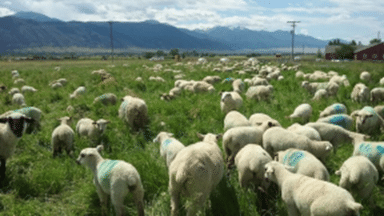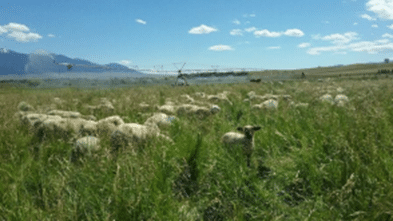Montana Highland Lamb
Whitehall, MT
Introduction

Dave and Jenny Scott have been on their Montana Highland Ranch since 1982. The farm is located between Bozeman and Butte, MT just off of I-90. The farm consists of 32 irrigated acres in Whitehall, Montana (elevation 4,200 feet). The first 20 years on the farm, Dave and Jenny milked 50 Guernsey and Jersey cows from 1982 to 2003. They were pasture-based, moving the cows twice daily for 20 years. Soil organic matter in 1982 measured a mere 1.3%, typical of bench ground in the surrounding valley today. It is important to note that historically soil organic matter (SOM) content would have been considerably higher, so by 1982 the soils being measured were already previously degraded through past cultivation and overgrazing.
SOM measurements in 2019 showed organic matter content of 5.5%.
Here is the Montana Highland Lamb soil health story. Think of Dave and Jenny as a test plot in a real farm setting.
The Transition Process
In 2003, Dave and Jenny sold the dairy cows and switched to 180 Polypay sheep. Polypay sheep are a medium sized, polled sheep developed in the 1960’s at the U.S.D.A. Sheep Experiment Station located in Dubois, ID. They are the product of a combination of four other breeds: Dorset, Targhee, Finnsheep, and Rambouillet. The specific purpose of this new breed was to produce a highly prolific maternal trait dual-purpose breed.
In the transition process, Dave and Jenny continued, as they had the previous 20 years, to apply 160 units of nitrogen fertilizer per acre annually, with 40 units applied each month of the four-month growing season. When reviewing yearly expenses, the annual fertilizer bill of $123 per acre stood out as an extreme cost. They were seeking a way to reduce this cost when Dave heard both Dr. Christine Jones (www.amazingcarbon.com) and Gabe Brown (www.understandingag.com) speak at a workshop in 2013. After in-depth conversations with Gabe, Dave understood that excessive nitrogen fertilization actually harms soil biology, soil physical structure, and soil function. It creates a cycle of negative compounding effects that is the opposite of what Dave and Jenny intended. At that point, they decided to start the transition away from reliance on external fertility inputs.
The Awakening
Adaptive Grazing - Increased Average Pasture Rest Between Grazing Events
During this transition, they increased average pasture rest between grazing events from 32 days to 42 days and continued to move the sheep daily through the paddocks. The simple act of lengthening the rest period between grazing events produces profoundly positive benefits that include allowing plants to reach greater stages of maturity, increase photosynthetic activity, sequester more carbon, better protect soil moisture and temperature, stimulate greater soil microbial activity which results in deeper soil aggregate formation and increased water infiltration rates, and better animal performance and health. In addition, lengthening the rest-rotation period allows for enhanced response from the latent seed bank and a resulting improvement in plant species diversity.

The goal was to allow the sheep to consume approximately 50% of the grass and provide adequate trample effect on the other 50%. The amount of trampled grass averaged 1,800 lbs. of dry matter (DM) per acre as measured by USDA NRCS Forage Dry Matter hoops. This is significant in that the average grazer does not have a total of 1800 lbs of forage DMA available for the combined grazing and trample. Dave and Jenny were able to produce so much forage DM that their trample alone common growth expectations. Relative to this, the equation is simple: More grass, more trample = more carbon. The pictures below show the progression from adaptive grazing event to resulting forage trample.


In addition, they delayed spring turnout of the sheep onto the new forage growth by one week. On the surface this does not appear to be a significant effect, but just one additional week of forage growth enabled them to graze taller grass all summer, as long as they maintained their appropriate grazing wedge. These changes resulted in greater ability to feed soil microbes with grass root exudates, and with available carbon from the decomposition of the trampled grass.
Fertilizer Reduction - Reduction in Fertilizer Applications
This resulted in increased mineral nutrient cycling, gradually eliminating the need for externally applied fertilization. Fertility reductions were initiated in 2014 as illustrated in Table 1

The reduction in fertilizer applications, combined with SOM increases that allowed for greater water infiltration capacity and reduced irrigation allowed Dave and Jenny to realize a $9000 reduction in input costs for 2019. Across 32 acres, this is a cost reduction of $281.25 per acre annually.
As a result of eliminating synthetic N applications, the amount of soil microbial fixed nitrogen produced each season has increased significantly. This is being tracked by the Haney Test. The correlation between the Haney Test projected nitrogen mineralization and the amount of grass that was produced during the grazing season is high and significant. Additionally, USDA NRCS Forage DM hoop monitoring indicated no decrease in grass production, in spite of the complete elimination of N fertilizer. In addition, sheep stocking rate remained constant.
In 2016, the last year of N fertility application, Dave fertilized in 25-foot bands (completely by accident) and noticed that except for about five percent of the pasture, there was even production and no visible striping. This gave him the confidence to go fertilizer-free in 2017.
Their grass production in 2017 and 2018 supported 180 ewes and 280 lambs, as in previous years. An unanticipated side benefit of the adaptive grazing practices was that winter stockpile pasture forage DM availability increased 2.3 times, resulting in 15,600 ewe days of winter grazing compared to the former average of 6,750 ewe days. Since winter hay feeding is by far the largest single annual expense in a livestock operation, the significant increase in winter stockpile DM provides opportunity for cost savings.
For a short video describing their winter stockpile grazing, go to: Regenerative Grazing: Learning from Nature. Stockpiled Grass
Lessons Learned
Benefits
The transition to adaptive grazing resulted in a slight decrease in individual lamb average daily gain (ADG) for weaned lambs, decreasing from 0.65 lbs/day to 0.62 lbs/day. This amounted to a total decrease in lamb ADG value of $1,490, or $5.41/lamb at $1.80 /lb. However, this was more than offset by the annual savings in nitrogen fertilizer ($3,926), irrigation energy (25% less, or $1,229), and irrigation labor (25% less, or $1,696), producing a yearly net savings of $5,361 or $167.53 for the 32-acre farm for 2017 and 2018.
Additional benefits include:
● Increased resiliency in the soil and response to challenges. For example, in 2016 a drought significantly reduced water availability from the nearby river. However, Dave and Jenny were able to continue optimum forage production with reduced irrigation due to better soil moisture retention. In the past, forage production declined significantly when drought was experienced.
● The improved soil microbial population has resulted in increased nutrient density in the forages leading to better end-product flavor profiles and improved sales and customer feedback.
● Farming is more fun! Dave and Jenny now have more time for themselves. They take more time for vacations and their love of camping.
● In 2019 Dave and Jenny were able to market all of their grass finished lambs directly to restaurants, Montana State University Dining Hall, retail stores, and direct to consumers. This is a direct result of their regenerative practices and ability to market those enhanced attributes. They plan to increase lamb sales by another 40 lambs in 2020. Compared to a live lamb market value of $1.80/lb, meaning the average lamb is worth $162 on the commodity lamb market, they are able to add value through direct marketing and increase the value per lamb to between $270 and $300.
Challenges
Dave and Jenny have found that the biggest challenge they face is themselves. How will they react when confronted with a problem, especially one that is unanticipated? Will they stay the course or will they bail?
As an example, in 2015, they experienced a significant increase in Barber Pole Worm parasite infestation in their sheep. It was unforeseen and discouraging. However, instead of relying on their old system of inputs, they thought of all of the potential of working with nature. Instead of using parasiticides and other chemicals that can cause damage to other beneficial organisms beyond the target pest organism (Barber Pole Worms), Dave and Jenny turned to fence line weaning of lambs, dramatically reducing the stress of weaning. This, in turn, greatly reduced.
Barber Pole Worm infestation. Additionally, they are now selecting for ewes that exhibit resistance to internal parasites.
Perhaps the biggest lesson Dave and Jenny have learned: respond to challenges with biology rather than with chemistry.
Summary
Dave and Jenny have discovered that working with nature instead of fighting nature reaps big rewards. The resiliency they have added to their farm since starting the regenerative transition has been priceless. Their mindset has changed so that whenever they do encounter a problem or challenge, they always ask how they can work WITH nature to resolve the issue rather than rote reliance on synthetic and chemical inputs.
Starting with soils that were less than 1.5% SOM and taking them to over 5.5% in such a short period of time has been very encouraging. They were told many times that it was not possible to alter SOM that rapidly. They even took an old dairy cattle drylot that was 1.0% SOM and increased the organic matter to 4.3% in just 5 years.
Dave and Jenny consider this an ongoing journey understanding that they will never achieve full regeneration, but that they can continuously make incremental progress that will improve their net profitability, soil health, ecosystem health, and quality of life for some time to come. It is a journey they are happy they started.
